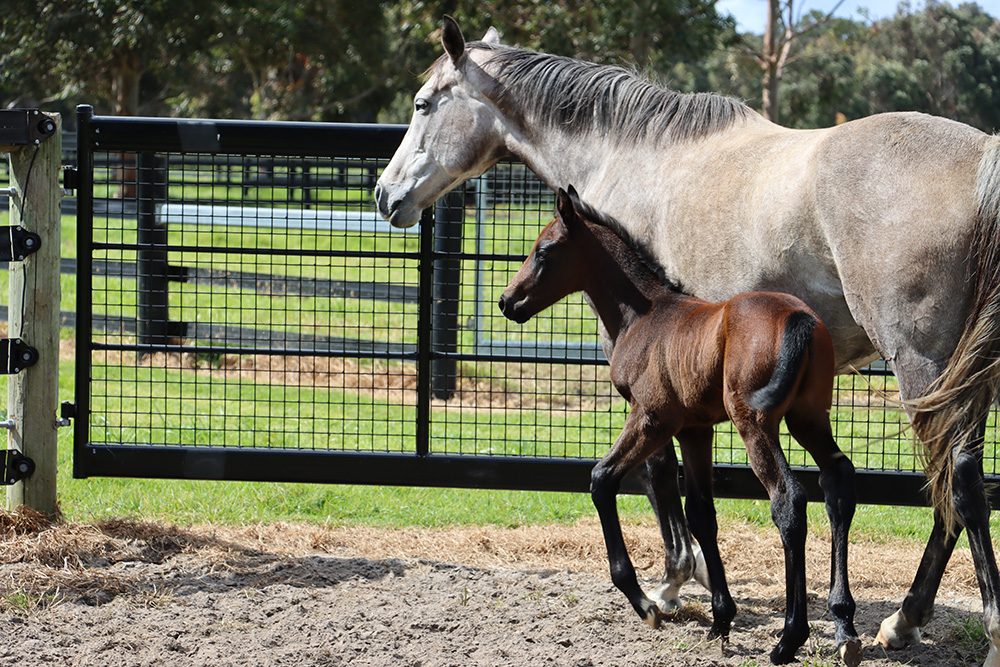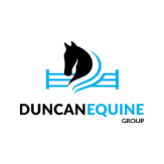Spring is in the air and foaling season has arrived! The arrival of new foals is incredibly exciting, but can also be slightly nerve-wracking. To help minimise your worries and ensure your new arrivals are as safe as possible, here’s our checklist for preparing your paddocks and fencing for foals – Everything your mares and their young ones will need to be safe, secure, and healthy:
1. Foal-proof fencing
Foals can be experts at slipping their way through gaps or finding their way under fencing as they’re much smaller than an adult horse. Highly visual, fencing with no large gaps is the most ideal for foals, as they’re less likely to have an accidental collision, injure themselves or end up separated from their mother on the wrong side of the fence – newborn foals can be quite uncoordinated! When installed and tensioned correctly, Stallion Rail has just the right amount of ‘give’ so that foals bounce off. The width of Stallion Rail means there is no risk of foals getting it wrapped around their delicate little legs.
For the ultimate foal paddock fencing, we suggest four rails of Stallion Rail, to prevent any risk of foals rolling under the bottom rail.

2. Foal Safe Gates
Many normal gate styles are okay for other livestock, such as cattle, but larger gaps between gate mesh or wires can be a serious hazard for horses. Gateways tend to be high-traffic areas, or where horses wait when anticipating feed time. This can result in horses kicking or striking out at one another near the gate or pawing at the fence. Gaps in gates that are large enough for horses to hook their shoes on or get a hoof through can be extremely dangerous. As flight animals, horses are prone to panicking when they feel trapped and can cut their legs or severely damage their hooves by pulling off the shoe forcefully.
Our Duncan Equine Horse Safe Gates are designed specifically to be as safe as possible and eliminate these risks. They’re designed with an oval rail top and bottom, for increased strength and visibility, as well as rounded edges that are safer for horses. The middle section of our gates are filled in with 50mm x 50mm mesh, which means there are no gaps for foals to squeeze through, or even get the littlest hooves caught.

3. A safe paddock surface
Another important factor to consider in a mare and foal paddock is the terrain. Steep sections, rock faces, holes, or dams and creeks can be high risk for foals as they are often quite uncoordinated in the early days. A fairly flat or gently undulating paddock is best for foals, especially when they like to run and play – testing out their newly found speed.
4. A source of shelter/shade
Most foals will be born throughout spring and summer, so it is especially important your foaling paddock has adequate access to shade for all the horses to shelter from harsh heat or sun in the warmer months, especially in Australia! Trees can be a great natural solution; however, it is important to consider if the trees offer shade at all times of the day. Tree lines on the edges of paddocks will only offer shade at certain times of the day, depending on where the sun is in the sky. Other safe and reliable options for shade are paddock shelters, which also provide protection from wet weather.
5. Suitable feed bins
Not all feed bins are suitable for mares and foals. Lactating mares need more food than most horses as she will also be feeding her growing foal. Remember that she will also be sharing her feed with her foal, and you will need a large feed bin, low to the ground that both of them can easily access. Our Duncan Equine Paddock Feeders have been designed by horse people for horse people, specifically to reduce the likelihood of being tipped over and thrown around. This reduces feed waste and provides a safe and durable paddock feed bin option for mares and foals.

6. Appropriate paddock mates
Horses are herd animals and feel safest when in a group, especially mares with new foals! If possible, it’s ideal to paddock mares and foals together in a group. This will result in more relaxed mares and foals that are able to socialise and play. When it comes time to wean your foals, it can be less stressful when they are weaned together with their other foal paddock mates. It is also important to keep young foals separate from adult horses that could be aggressive.
7. Located for regular inspection
It’s important to position your foaling paddock in an easily to access location. Mares that are close to foaling and newborn foals will need regular inspection and or supervision, so we would suggest building or positioning your foal paddock close to your building infrastructure or easily accessed by a laneway or driveway. Some people also choose to include a holding yard in the corner of the paddock, in case one horse needs separation from the rest of the herd to see a vet or farrier. When you choose Ducan Equine fencing for your property, we include complimentary planning! Our experienced team will design your ideal fencing layout and work with you to meet your specific requirements, including the location of your foal paddock on your property so that pregnant mares and new foals can be easily and regularly checked.
Remember that a safe environment is crucial for the development and well-being of your foal. It is important to regularly assess and update the paddock to ensure it remains a safe and suitable space.
Get in touch!
Do have any questions about fencing for mares and foals on your property? The knowledgeable team at Duncan are happy to answer any questions you have! You can contact the team on 1800 259 365 or at info@duncanequine.com.au




